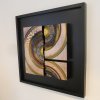... I don't want to dance any more. I trying to find our what to use to keep my PM from dancing when I turn off centered work. I typically use 1 1/2" x 12" x 12" soft maple, faceplate mounted and I move my 4" FP to different positions on the back of stock to create different center points of turning. See the attached finished work to get an idea of what I turn.  My first attempt was to add a shelf and 6- 60lbs bags of sand. I have the 18" bed extension in the lower position and the head stock moved all the way to the end to utilize a larger diameter wood. I love this feature for this type of work. Anyway in this situation I could only get about 425rpm with our shaking the crap out of the lathe when I moved the face plate to and off center location.
My first attempt was to add a shelf and 6- 60lbs bags of sand. I have the 18" bed extension in the lower position and the head stock moved all the way to the end to utilize a larger diameter wood. I love this feature for this type of work. Anyway in this situation I could only get about 425rpm with our shaking the crap out of the lathe when I moved the face plate to and off center location.
The second attempt was to remove the sand bags and bolt the lathe to the floor by placing an 1/2" x 2" x 23+" steel bar drilled to slip over the top of the levelers and then bolted the bar to the the floor on each end, using 4- 1/2" x 6" weage bolts. Since my floor was not level I ended up screwing the levelers down about an inch and a half from the base of the leg, big mistake. I thought I was all set..put my off center work on the head stock and slowly brought up the speed. At about 530rpm I was back at doing the dance, and I am now left with 2 bent leveling legs and a lathe that has its mind set on dancing.
Any ideas or thoughts...Thanks
 My first attempt was to add a shelf and 6- 60lbs bags of sand. I have the 18" bed extension in the lower position and the head stock moved all the way to the end to utilize a larger diameter wood. I love this feature for this type of work. Anyway in this situation I could only get about 425rpm with our shaking the crap out of the lathe when I moved the face plate to and off center location.
My first attempt was to add a shelf and 6- 60lbs bags of sand. I have the 18" bed extension in the lower position and the head stock moved all the way to the end to utilize a larger diameter wood. I love this feature for this type of work. Anyway in this situation I could only get about 425rpm with our shaking the crap out of the lathe when I moved the face plate to and off center location. The second attempt was to remove the sand bags and bolt the lathe to the floor by placing an 1/2" x 2" x 23+" steel bar drilled to slip over the top of the levelers and then bolted the bar to the the floor on each end, using 4- 1/2" x 6" weage bolts. Since my floor was not level I ended up screwing the levelers down about an inch and a half from the base of the leg, big mistake. I thought I was all set..put my off center work on the head stock and slowly brought up the speed. At about 530rpm I was back at doing the dance, and I am now left with 2 bent leveling legs and a lathe that has its mind set on dancing.
Any ideas or thoughts...Thanks
